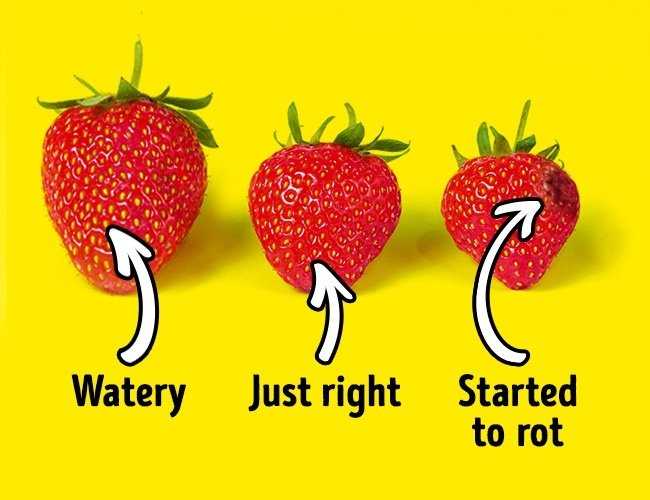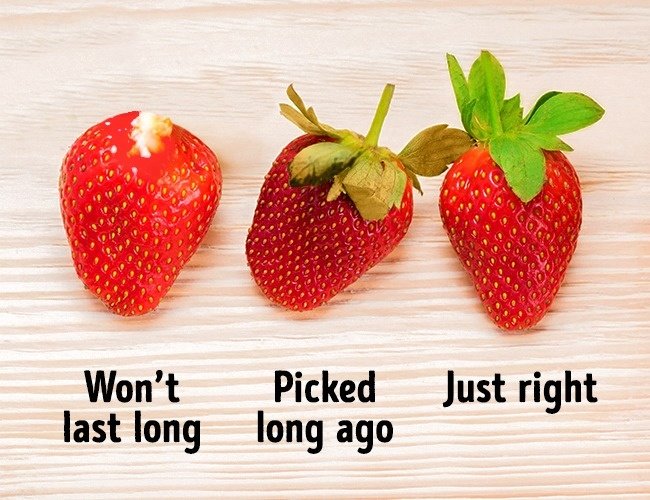Strawberries: How to Choose and Store Fresh, Ripe Berries
Known for their sweet and juicy flavor, strawberries are packed with essential nutrients like magnesium, potassium, and antioxidants. However, selecting the best strawberries can be a challenge. Here are **5 Ways to Choose and Store Fresh, Ripe Strawberries** to help you master this skill:
Contents
[5 Ways to Choose Fresh, Ripe Strawberries](#choose-strawberries)
[1. Scent](#scent)
[2. Color](#color)
[3. Shape and Size](#shape-size)
[4. Hull and Cap](#hull-cap)
[5. Seeds](#seeds)
[How to Wash Strawberries](#wash-strawberries)
[How to Store Strawberries](#store-strawberries)
5 Ways to Choose Fresh, Ripe Strawberries
1. Scent
 © depositphotos.com
© depositphotos.com
The first and most important factor when choosing strawberries is their aroma. Take a whiff and look for a distinctive and sweet smell. Avoid strawberries with a faint or artificial scent, as they may have been treated with chemicals.
2. Color
 © depositphotos.com
© depositphotos.com
High-quality strawberries are typically bright red and glossy. Be wary of strawberries with a deep red hue, as they may have been artificially colored. Additionally, avoid berries with green spots, as they will not ripen further once picked.
3. Shape and Size
 © depositphotos.com
© depositphotos.com
The shape and size of strawberries vary depending on the variety, so there is no universal recommendation. However, be cautious of unusually large strawberries that appear plump, as they may have been injected with water. Inspect the berries for any soft spots or bruises.
4. Hull and Cap
 © depositphotos.com
© depositphotos.com
The hull and cap of a strawberry can also reveal insights about its quality. Firstly, opt for berries that still have their stems and green caps intact. Secondly, dry or yellowing hulls indicate that the strawberries have been sitting on the shelf for several days, so it’s best to avoid them. As a tip, if there’s a gap between the hull and the berry, it may be sweeter.
5. Seeds
 © pixabay.com
© pixabay.com
Strawberries with seeds that are spaced further apart are said to be grown in a wider space, resulting in sweeter fruits. While there’s no scientific evidence for this specific trick, why not give it a try?
How to Wash Strawberries
Here’s how to clean strawberries naturally using household ingredients:

Soak the strawberries in rice-washing water for a few minutes to remove dirt and neutralize any pesticide residue (if any).
Rinse the strawberries gently in clean water with a bit of vinegar to kill bacteria, then rinse again with clean water to remove any vinegar taste.
Note: Avoid soaking or rinsing for too long or too vigorously to prevent bruising.
Drain the washed strawberries in a colander or pat them dry with a clean towel or paper towels before storing.
How to Store Strawberries
Line a food-safe container with a layer of dry paper towels or clean cloth. Place a single layer of strawberries, then top with another layer of paper towels. Repeat this process until the container is full, with a final layer of paper towels on top. Close the container and refrigerate.
The paper towels or cloth absorbs moisture to prevent the strawberries from becoming soggy. It also keeps them from rubbing against each other, which can cause bruising, allowing you to store the strawberries in the refrigerator for up to a month.

Remember to change the paper towels if they become damp to extend the storage life.
Strawberries are loaded with vitamins and minerals that fight aging and reduce stress. So, don’t let the hassle of selecting them keep you from enjoying this health-boosting fruit!
We hope this article has equipped you with the knowledge and skills to choose, wash, and store fresh strawberries like a pro.
The size and shape of strawberries depend on the variety, so there isn’t a specific rule. However, be cautious of unusually large, plump strawberries as they may have been injected with water to increase their weight and size. Always check for soft spots or bruises, regardless of size.
Yes, the color and appearance of strawberries are important indicators. Look for a bright red, glossy color. Avoid strawberries with an overly deep red hue as they may have been artificially colored. Also, steer clear of berries with green spots, as they won’t ripen further. Check the hull and cap; dry or yellowing hulls mean the strawberries are past their prime.
The scent is a good indicator of sweetness. A strong, sweet aroma indicates ripe, flavorful strawberries. Additionally, if there’s a noticeable gap between the hull and the berry, it may be a sign of a sweeter fruit. Also, look for strawberries with seeds that are spaced further apart, as they are said to be grown in wider spaces and are therefore sweeter.
Soak strawberries in rice-washing water for a few minutes to remove dirt and neutralize pesticides. Then, gently rinse them in clean water with a bit of vinegar to kill bacteria, followed by another rinse in clean water to remove the vinegar taste. Pat them dry before storing.
Line a food-safe container with paper towels or a clean cloth. Place a single layer of strawberries, then top with another layer of paper towels. Repeat this process until the container is full, ending with a final layer of paper towels. Close the container and refrigerate. The paper towels absorb moisture, preventing the strawberries from becoming soggy and bruised, and they can last for up to a month this way.
Selecting Yummy Kiwis: A Guide
Do you want to pick a delicious kiwi but don’t know where to start? Look no further – this article will provide you with all the information you need to choose a delicious kiwi! Packed with minerals, vitamins, and antioxidant properties, kiwi is a great addition to your diet and may even treat a variety of ailments. Let’s find out how to select the best kiwi for you!



































